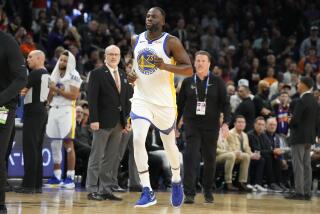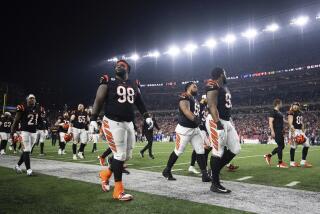Gifted Green Honors Contract
- Share via
CHARLESTON, Ill. — The term holdout has become so commonplace in the National Football League this preseason it could be mistaken for a position on a team.
Consider:
Dan Marino is holding out on the Miami Dolphins. Mike Singletary, Al Harris and Todd Bell are holding out on the Chicago Bears.
The Philadelphia Eagles have five holdouts--Wilbert Montgomery, Mike Quick, Jerry Robinson, Dean Mirdaldi and Dennis Harrison.
Holdout, on many of these teams, is the most significant position on the club roster. The position, of course, is a financial one. And in many cases its nickname is greed. Its favorite play, renegotiation.
If the holdouts banded together as a team, they probably would be good enough to reach the playoffs.
But there are some Pro Bowlers who are cut from different cloth. Consider wide receiver Roy Green of the St. Louis Cardinals.
Green, arguably the most feared offensive player in the NFL, remains shockingly underpaid compared with his peers.
He is in the second year of the three-year contract that now pays him $195,000 a season. He earns $5,000 less than second-year Cardinal Clyde Duncan, who hasn’t yet caught his first NFL pass.
Green is earning $20,000 less than the average salary for his position.
Yet, view his record:
--More yardage (2,782) gained and more pass receptions (156) than any receiver in the NFL the last two seasons.
--More touchdowns (26) than any player in that span except for Miami’s Mark Duper.
--His 12 touchdown catches last season averaged 45 yards, the highest in NFL history.
--His 1,555 yards last year were the third highest receiving yards of all time behind Charlie Hennigan and Lance Alworth.
Yet next season, the final year of Green’s three-year contract, calls for an increase of $15,000 to $210,000.
He asked the Cardinals to tear up the old contract last season. The club refused.
So why isn’t Green sitting at home, playing holdout, as are two of his teammates, Pat Tilley and Danny Pittman, and enough others around the league to fill a team?
Green treats contracts the old-fashioned way--he honors them.
“Why didn’t I hold out?” he repeated the question. “Mainly, it’s because I’m from the old school. The way I was raised, we were taught the difference between right and wrong, fair and unfair.
“I expressed my sentiments about it last season. I’m under contract, so I’m here in camp. I’m confident the organization knows of my contribution, and that someday they’ll eventually compensate me. Nobody said life is always fair.”
For Green it was no big decision to live up to the contract he signed. Nor would he criticize the holdouts that abound today.
“Being underpaid does bother me when I think about it. An injury can end a career in one play. It was good when I signed it, so I’ll live with it,” added the unusual 28-year-old athlete, nicknamed Jet Stream.
As a complete receiver, he is part blur, part glue, part silk, part brain.
Last season, Giants Coach Bill Parcells called him the best offensive player in football.
“He puts more pressure on your defense than any team you’ll play this season. You pay more attention to Roy Green than anyone else,” said Parcells. “He has rare speed. He actually seems to get faster the farther he runs down the field.”
Green runs 40 yards in 4.28 seconds.
Green joined the Cardinals as a defensive back and kick returner in 1979. He tied an NFL record with a 106-yard kick return for a touchdown against Dallas in his rookie year.
He played offense and defense in 1981. He made history that season when he became the first player since Eddie Sutton of Washington in 1957 to catch a touchdown pass and intercept a pass in the same game. Green was on the field for 99 plays that day.
Since becoming a full-time receiver in 1982, he has used his knowledge as well as his speed to break clear of defensive backs.
“When I come up to the line, I can spot the kind of coverages immediately,” he said. “I have an idea what they’re going to do. It’s a great advantage.”
In preseason camp, he is preparing his own strategies and thinking out new ways to stop himself.
“You try to anticipate what other teams will try against you. Every year teams come up with something different. A receiver has to be ready for it. It’s a new, more complex system every season. It’s like a chess game. I like that part of pro football.”
The NFL doesn’t stand still any more than Roy Green does.
He rates the Giants and Philadelphia as the toughest secondaries he faces, and Gary Green of the Rams, Lester Hayes of the Raiders and Mark Haynes of the Giants as the toughest on man-to-man coverage.
Green is pleased that the Cardinals are planning to minimize the variations of their passing attack this season, believing, perhaps, the team had gotten too fancy.
“I’d like us to do a few things very well. Have a smaller package of 15 to 17 plays we can do very well.”
How would Roy Green the defensive back try to cover Roy Green the pass receiver?
“Well,” he replied with a slow smile, “I’d begin by asking another defensive back for some help.”
More to Read
Go beyond the scoreboard
Get the latest on L.A.'s teams in the daily Sports Report newsletter.
You may occasionally receive promotional content from the Los Angeles Times.










